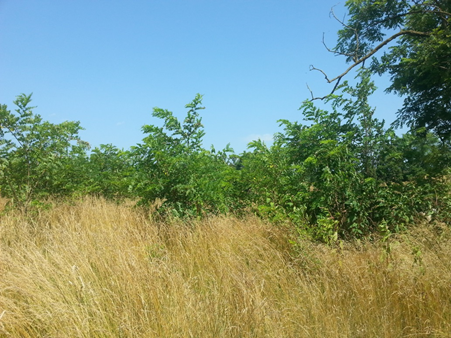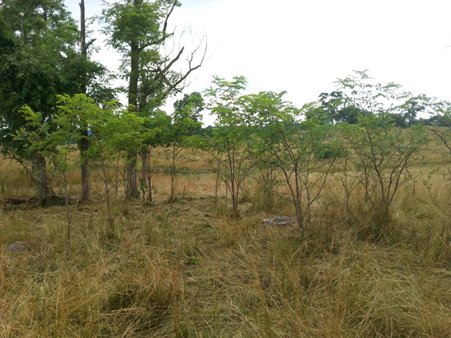My 4 children, wife, and I returned to our 10th generation farm (circa 1773) in 2009 after my 1st overseas deployment with the Air National Guard. My Great-Grandfather was the last Holsinger to live on the property in the early 1970s, but the family continued to farm the property in the 70s, 80s, and 90s. Back then, the farm was part of a 70 head cow/calf operation, fenced as a single 72-acre tract, with cattle drinking from the ponds, stream, and house spring. We spent 2 weeks a year making tons of hay, and the rest of the year we fed that hay 2-3 days a week along with silage trucked from another farm 20 miles away.
That was then…This is now.
After returning to the farm in 2009, we decided to implement permanent cross fencing, stream exclusion, and other best management practices to assist in rotational grazing. A 2010 snapshot of the 72 acres included: 12 acres devoted to Conservation Reserve Enhancement Program (CREP)/Environmental Quality Incentives Program (EQIP), 8 acres for the farmhouse & barnyard, and 5 permanent paddocks with a central waterer, each about 10 acres in size. We utilized those paddocks and temporary electric fence to graze a forage mixture of orchard grass, alfalfa, bluegrass, bromes, vetch, clover, and tall fescue, as it is quite competitive on my farm. In those first few years I realized, or should I say my cattle informed me through their panting, huddling around the waters, and poor spring calving conception rates, that they wanted – no, needed! – shade. I soon realized that the last 70+ years of clearing the cross-fencing and trees to allow easier and unfettered machinery access to the property had resulted in limited shade in the majority my 10-acre permanent paddocks, and no shade in my ½-acre or less temporary fencing, rotational grazing paddocks.
I had a problem, and I asked the internet to point me toward help. Funny enough, I see many in today’s society turning to the solutions of the past. Regarding my problem, a search engine suggested a book published first in 1950. Lucky for me, if there is one thing that I can finally make time to do during those 8–10-hour flights across the oceans several times a week, it’s read. So, I bought a used copy of Tree Crops – A Permanent Agriculture, by J. Russell Smith. That $7 purchase has become a foundation book for the principles in use on our farm – specifically, developing a Two-Story Agriculture.
I have since planted trees, implementing silvopasture across 38 acres of the farm; 18 acres in 2013 and 20 more acres in 2016. The 2013 project took months of research, gathering input from foresters, graziers, academics, and NRCS professionals. My primary goals were to implement two-story agriculture, produce marketable timber, provide shade and windbreaks, and to share my experiences so that others can learn from my experiments. I use the word “experiment” because my 2013 silvopasture installation was a combination of ideas, concepts, and specific tree varieties from a multitude of experts. I installed both 2- and 3-row plantings to induce quick straight growth. We planted quick growing pine species, such as the pitch-lob hybrid, to create competition for light and induce a vertical growth profile in our hardwood trees. My vision of a two-story agriculture included planting black walnuts for marketable timber and walnuts for the kids to harvest. The thornless honey locust, Dunstan Chestnuts, and persimmon would allow me to graze sheep and hogs on nuts, fruit, and sugary pods. Lastly, yellow poplar and black locust were included for their fast growth and potential lumber products. The shining star from this experiment has been the black locust because of the versatility and diverse benefits it brings to my farm and my animals.
My farm already had a small black locust grove that had been there since I was a child. Historically, under continuous grazing, no volunteer saplings could grow. However, since rotational grazing limits access and allows rest for growth, the grove has been expanding and thriving. My cattle love the shade and grasses that flourish under them year-round, but in summer the cattle choose to pass up fresh, lush grasses to strip leaves from the lower locust branches within reach. Not only can the cattle browse the lower branches, but through the technique of hinge cutting (Figure 1) I can graze the entire canopy of a thinned black locust tree for several months or maybe years, after which time the firewood or possible fence posts can be harvested (Figure 2).
 Figure 1. Example of hinge cutting. Hinge cutting is a technique in which a tree is cut halfway through until it starts to fall. A portion of the tree is still connected to the root system so leaves will still grow in the spring. This technique allows grazing of all the leaves and leaf regrowth until the tree reaches its final marketable harvest as firewood or locust posts.
Figure 1. Example of hinge cutting. Hinge cutting is a technique in which a tree is cut halfway through until it starts to fall. A portion of the tree is still connected to the root system so leaves will still grow in the spring. This technique allows grazing of all the leaves and leaf regrowth until the tree reaches its final marketable harvest as firewood or locust posts.
 Figure 2 A.
Figure 2 A.
 Figure 2. B.
Figure 2. B.
Figure 2. A) Volunteer black locust silvopasture before cattle grazing B) The same black locust silvopasture after a few hours of rotational grazing. These locusts are 1 and 2 years old. They were thinned the year this picture was taken and at 4-5 years old were hinge cut as seen in Figure 1.
The quick growth of black locust allows me to return to full use of the pasture within 4 years of establishment. After tree planting, I exclude these sections of the pasture from grazing until the trees can survive cattle grazing (Figure 3 and Figure 4). The establishment of silvopasture in my existing pastures requires me to exclude grazing from 14-18% of my existing forage. As such, the quick growth of the black locust is better for a beef operation than other species, because the pasture acreage can be added back to the rotation sooner than pastures planted to slower growing tree species. Additionally, black locust trees do not require a “trainer tree”, in contrast to slower growth species, to induce early vertical growth since they are self-competitive for light and reach for the sky. Another benefit of black locust is that they are very forgiving. I have found that if over-grazed or accidentally hit with a bush-hog, young trees will quickly come back quite well and often quicker than expected since they have an existing root structure to feed from.
 Figure 3. Electric fencing protecting new black locust plantings (4-month seedling) from grazing cattle.
Figure 3. Electric fencing protecting new black locust plantings (4-month seedling) from grazing cattle.
There are a few challenging aspects to black locust management. Black locusts have thorns which can be painful, either to skin/body or to pocketbook when they find a tractor/truck tire. Additionally, without cattle grazing very young sprouts/saplings, these trees are prolific and can take over a pasture. Although this can be a challenge, I have harnessed this aggressive growth and establishment to my benefit. I have had over 90% survivability with my black locust plantings, so as a recommendation, be sure to plant them at the final spacing you want them. However, if you do plant them too close or if you have multiple volunteers, you can easily control them with a bush-hog or utilize hinge cutting or thinning for profit.
 Figure 4. Locusts pictured are 4 years old. This fence will be removed in spring of the 5th year after stockpiled fescue grazing is complete. Lower branches will also be trimmed to improve form and allow for better air flow under the canopy.
Figure 4. Locusts pictured are 4 years old. This fence will be removed in spring of the 5th year after stockpiled fescue grazing is complete. Lower branches will also be trimmed to improve form and allow for better air flow under the canopy.
Although management of black locust can have its challenges, these are greatly outweighed by the benefits. I would recommend black locust for silvopastures, especially new silvopasture and those new to managing silvopasture, because of its quick growth, strong competition to pasture species, open tree branch form (which allows light to the forage canopy), nitrogen fixing root system, and its forgiveness to minor mismanagement or overstress. The black locust has been an integral part of my farm’s journey to more a diverse, profitable, and sustainable operation.

